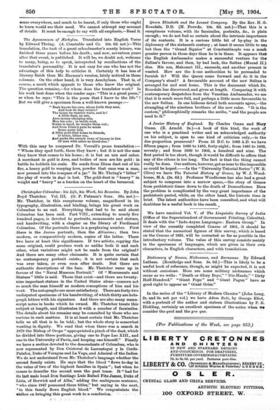Christopher Columbus : his Life, his Work, his Remains. By
John Boyd Thatcher. Vol. III (G. P. Putnam's Sons. 36s. net.)— Mr. Thatcher, in this sumptuous volume, magnificent in its typography, illustration, and binding, brings his great work on Columbus to an end. Everything that had to be said about Columbus has been said. Part VIII., extending to nearly five hundred pages, is devoted to portraits, monuments and statues, and handwriting, with a chapter on the library of Ferdinand Columbus. Of the portraits there is a perplexing number. First there is the Jovian portrait; then the Altissimo ; then two modern, or comparatively modern, copies of the latter. These two have at least this significance. If two artists, copying the same original, could produce work so unlike both it and each other, what variations might not be made from the original? And there are many other claimants. It is quite certain that • no contemporary portrait exists ; it is not certain that such was ever taken, or even soon after death. But there are authentic descriptions of the face. Mr. Thatcher sums up in favour of the "Naval Museum Portrait." Of "Monuments and Statues" little is said. Those that exist—and there are twenty- nine important statues in the United States alone—concern not so much the man himself as modern conceptions of him and his work. The autographs are more satisfactory. There are forty-two undisputed specimens of his handwriting, of which thirty are holo- graph letters with his signature. And there are also many manu- script notes in books which he owned. Mr. Thatcher treats this subject at length, and illustrates it with a number of facsimiles. The details about his remains may be consulted by those who are curious in such matters. It is at least certain that Mr. Thatcher tells us all that is to be told ; but the whole story is somewhat wanting in dignity. We read that when there was a search in 1878 the Bishop of Orope "appropriated a pinch of the dust, which he divided into three portions, giving one to Pope Leo XIII., and one to the University of Pavia, and keeping one himself." Finally we have a section devoted to the descendants of Columbus, who is now represented by Don Cristoval de Larreategui y la Cerda- Palafox, Duke of Veragua and La Vega, and Admiral of the Indies. We do not understand from Mr. Thatcher's language whether the second family exists. He says that the blood "flows to-day in the veins of two of the highest families in Spain"; but when he comes to describe the second uses the past tense. It "had for its last male head Don Santiago Luis Rafael Fitz-James, Duke of Liria, of Berwick and of Alba," adding the ambiguous sentence, "who since 1847 possessed these titles," but saying in the next, 1/4 in this family flows English blood." We congratulate the author on bringing this great work to a conclusion.






































 Previous page
Previous page